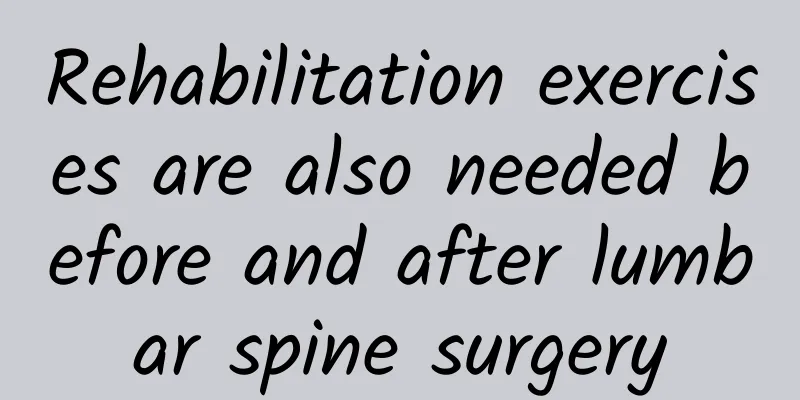Rehabilitation exercises are also needed before and after lumbar spine surgery

|
Almost everyone will experience different degrees of low back pain in their lifetime, so once low back pain occurs, we should change various bad posture habits to reduce the impact of pain on our daily life. In general, the most common clinical diseases that cause low back pain include lumbar disc herniation, lumbar spondylolisthesis, spinal stenosis and other problems. If conservative treatment cannot achieve effective improvement, you can choose lumbar surgery to reduce the pressure on the surrounding nerve tissue and restore the physiological curve of the spine, stabilizing the lumbar spine on the correct biomechanical line. In previous popular science, the editor has mentioned the rehabilitation training methods for conservative treatment of lumbar disc herniation. Today, I will popularize the rehabilitation exercises for lumbar surgery, which means that our rehabilitation training should begin before surgery. 1. Preoperative rehabilitation education and training When patients are advised to choose lumbar spine surgery, a complete rehabilitation education should be conducted on the rehabilitation treatment before and after the operation, including stability training, stretching activities and adaptive exercises, as well as pain management, wound care, correct posture and other related issues. Considering the increase in bed rest time after surgery, patients should undergo patient training suitable for themselves before surgery to improve their cardiopulmonary exercise function, and use barbells, sandbags, elastic bands, etc. to perform muscle strength training for the upper and lower limbs. 2. In the first postoperative stage (week 1-2), a waist brace is usually worn to restrict some activities. Waist flexion, extension, lateral bending or rotation activities are strictly prohibited. The biggest problem in the first stage is pain management. In addition to medication, some physical factors can also be used to help relieve pain, such as cold therapy, transcutaneous electrical nerve stimulation (TENS), etc. If you can tolerate it, you can also do some strength training for the hip muscles and quadriceps according to your personal situation. You can also walk slowly at home or in the community with auxiliary equipment, and avoid sitting for more than 20 minutes. In daily life activities, you can add handles and use shoe horns to solve the troubles caused by limited movement. 3. The second stage after surgery (week 2-6) After the pain is relieved, still avoid waist movement in all directions, and gradually increase the sitting time to about 30 minutes. In addition, you can also do the following exercises, including abdominal muscle training, sliding your heels on the bed to do hip and knee flexion exercises, abdominal muscle plus knee flexion and abduction exercises, etc. At the same time, you can also go to the rehabilitation clinic for power bicycle activities to gradually improve your daily living activities and strive to be able to take care of yourself completely in the sixth week. 4. The third postoperative stage (week 6-14) Stability training is the primary task of this stage. After supporting the lower limbs in the supine position, resistance exercises can be performed with elastic bands, and the abdominal muscles can be kept stable to effectively control the lumbar spine. The next step can be to start from the supine position and then progress to the four-point kneeling position (hands and knees on the ground at the same time). The change of body position is also conducive to daily life activities. In addition, you can do lunges and squats with the spine in an upright position, and you can gradually add small dumbbells. 5. The fourth stage after surgery (weeks 14-22) During this stage, the spine still needs to be kept in a neutral position for daily exercise, but resistance training can be appropriately increased. Gradually walk indoors without the assistance of crutches or walkers, or walk outdoors in a safe environment. Improve sitting tolerance according to your work and life needs, and consult the surgeon whether the brace can be removed. 6. The fifth stage after surgery (after the 22nd week) Most patients can start normal life activities at this stage, but they still need to pay attention to the way the waist is exerted when lifting heavy objects. You can gradually return to sports at this stage. If you need to do some specific activities, ask the surgeon whether you need to wear a brace. If you have good control of your trunk, you can start upright weight-bearing resistance training, and the spine is always in a safe neutral position. |
<<: Scientific research interpretation helps you solve the confusion about exercise methods
>>: Where can I not see the lanterns? - Health preservation during the Lantern Festival
Recommend
Is it normal to feel sleepy during late pregnancy?
Pregnant women begin to slack off when they reach...
Why do I feel bumps when I touch my cervix?
Since the cervix is connected to the vagina, it...
Five Nobel Prizes are related to it. Why is vitamin B so important?
Tuchong Creative In recent years, vitamins have b...
Superconducting painless abortion technology advantages
Many people are not familiar with painless aborti...
What are the precautions and treatment methods for abortion?
There are two ways for women to have an abortion,...
Should I wear a belly band when sleeping at night?
For postpartum women, the part that is most likel...
Menstruation is not clean and bright red for 20 days
Some women's menstrual period has not ended e...
How should a thick cervix be treated?
Thick cervix is medically known as cervical hyp...
Can hawthorn brown sugar treat amenorrhea?
There are many factors that cause amenorrhea in w...
How to reduce uterine contractions during second childbirth
With the relaxation of the two-child policy, many...
Will drinking during menstruation affect menstruation?
Nowadays, more and more young women like to drink...
Fruits are getting sweeter. Is it a "sweet gift" or a "sweet crisis"? | Ronggeluoke
Fruits are getting sweeter and sweeter. Is this a...
It's been nine days since my period started and there's still a little bit of
Women's menstruation is regular every month, ...
Will there be more vaginal discharge before menstruation?
Before a woman's menstruation comes, there wi...
Is female private hair removal good?
The hair on the female private parts is also call...









